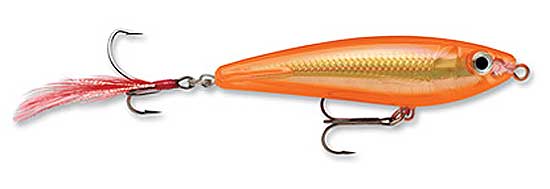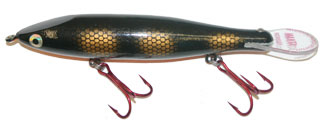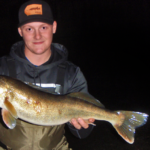By Andrew Ragas
I walked in my waders along the shores of a small northeastern Illinois tributary stream with stealth, casting my Shallow Manta through the pool to any current seams and deep holes I saw. The cool November climate and cold 40 degree water temperatures called for a slow retrieve with longer pauses through the deepest holes I could find. Most of the water wasn’t pristine quality or picturesque looking, but terribly urban with rip rap concrete and drainage pipes everywhere. Despite the artificial habitat and surrounding environment heavily impacted by man’s work and with small remnants of an abused polluted history, I encountered a scrappy mid 30-inch muskie that came charging out from its staging hole. My next cast I proceeded to catch it on the figure-eight.
Several years ago this stream might have been lifeless thanks to man’s neglect, urban abuse, stream degradation, and pollution. Today, the stream, along with many others in northeastern Illinois, has greatly cleaned up, and now supports all types of aquatic life. Through stocking efforts and extensive migrations from our region’s network of inter-connected streams, muskies have made their way into my local river and a handful of others. This species has defied the odds of fisheries managers and anglers alike, able to survive impaired water quality and degraded habitats. With muskies taking up residence in many of my stream’s deeper holes, it’s hard for many anglers to believe they thrive in such underrated fisheries within a major metropolitan region. I was once a skeptic. You won’t see me complaining today, especially with new and unique opportunities to now catch them locally.
Muskie fishing used to be a sport that mainly required extensive and expensive travels for a quality experience. Not anymore if catching is the objective. Today, some of the great, new success stories in muskie fishing’s expansion involve newly created urban opportunities and fisheries.
Muskies live in small rivers and streams across the entirety of their home range. Most are native fisheries, or rehabilitated, while others are stocked and artificial like the suburban Chicago streams I fish. Across the musky’s range, several underutilized streams and rivers contain healthy moderate, fishable populations of muskies that include some larger individuals if unexploited and given the chance to grow. Smaller waters receive the least pressure and angler exploitation, and are the easiest in which to encounter muskies throughout their range.

Small rivers and streams such as this one in northern Illinois meanders through municipalities and urban areas. Muskies thrive in many river and stream environments. Good water quality is preferred, but once-skeptical anglers like me are quickly discovering that muskies will live and grow surprisingly well in less than ideal water quality and habitats too.
Fish Behaviors are Relative to Season
Rivers and streams, in general, are excellent muskie fisheries. Seasonal muskie locations in these systems can often change drastically due to changes in season, but they can also occur across much shorter time spans such as floods and other biological or natural causes. When targeting muskies in any river, I often fish specific locations based on season and water temperature.
SPRING – Muskies are migratory river fish, and during spring they will usually migrate upstream to spawn and often concentrate below obstructions such as dams and other man-made barriers. They will also move into upstream backwaters and ditches, and networks of small feeder streams.
Most barriers such as low dams and shallow riffles will not stop even the largest of muskies, considering how strong and determined these fish are, and the great motivation to reproduce. On some northern Illinois rivers, low head dams are no longer a detrimental factor to fisheries as state-funding has dismantled many. This has greatly improved river and water quality health, and long-range spawning migrations for many fish species.
Due to siltation and poor habitat, muskies are unable to spawn in any northern Illinois rivers. Despite this against all-odds scenario, they are still programmed to undergo the motions of reproduction. Even if reproduction in the system is limited or nonexistent, muskies will always respond to their biological urges.
During the spring season, muskies can be found in high concentrations and will often be very active. Fishing results may be successful but bites can be tricky to come by as fish usually tend to be more interested in reproduction than feeding.
Spawning migrations are dictated by water temperature which is controlled by weather. On the northern Illinois streams, spawning migrations can occur anywhere from late February through April, depending on how quickly the water warms, and if water level conditions are comfortable to the preference of the specific fish. Muskies will begin to move towards prime spawning locations at water temperatures of 45 to 55 degrees. The length of the individual journey will determine how quickly the muskies must get on the move. The period of prespawn migrations and congregations is one of the best times of the season to catch truly large fish. Slow erratic presentations and attention-getting noisy baits often work very well.
Following the spawn, muskies in the largest rivers to the smallest streams are usually looking to move towards their summer haunts as quickly as possible. Fish are often beat up looking due to the rigors of spawn, but they do want to eat and are very catchable on aggressive tactics that includes jerkbaits and loud and noisy lipless crankbaits.
SUMMER – Summertime stream location is based on ideal, comfortable water temperatures (60-75 degrees) and even more importantly on forage migrations. If you are seeing lots of suckers and shad present in the vicinity of your wading and shore fishing, muskies won’t be far away.
Where muskies end up after their post spawn migration depends on river conditions and forage location, and this can vary greatly from one season to the next. The most major factors that affect summer muskie location in rivers are water level, current, water clarity, forage location, water temperature, and oxygen levels.
During normal summer conditions muskies will roam freely throughout the stream in pursuit of forage. Otherwise, muskies will set up in preferable structure and ambush areas near or amidst the forage. Often, forage fish species will make their own summer migrations in search of its own food and homing, and muskies will follow. Muskies will often hold in deeper tailwaters and pools, near bridges and their abutments, and man-made rip-rap and rock walls. They will also ambush from natural cover such as log jams and laydowns, weeds and vegetation, and sit in deep pools and holes patiently waiting for unsuspecting baitfish to pass by.
Fast moving, aggressive presentations such as bucktails and topwaters that enable me to quickly cover water produces best results.

Environmental changes such as extreme summertime heat, which is a real problem to several fisheries in this part of the Midwest, will cause muskies to undergo drastic behavioral changes. At many fisheries, these extreme conditions lead to annual summertime fish kills. If conditions become unfavorable in one part of the river, muskies will often move to an area more suited to their needs. If the conditions that they are escaping are physically stressful and potentially harmful, the need for survival will supersede everything else.
During a typical July and August heat wave, many northern Illinois rivers boil at 90 degrees. Survival becomes urgent as muskies begin to undergo harmful bodily stress. Hot water is harmful to muskies because it is poorly oxygenated. The warmer water gets the less dissolved oxygen it possesses. As water warms, muskies require more oxygen in order to survive. Warm water temperatures are proven to be lethal to muskies due to suffocation and lactic acid buildup. Fishing for them results in imminent death to the fish if caught.
When climate becomes hot and water temperatures are warmer than 80 degrees, muskies will seek cooler water. Locating cool water in small rivers, especially in an urbanized area is near impossible. In this region, muskies will settle into the fastest, usually shallowest water with current they can possibly find. They will lay belly to the bottom, with face into the current, motionless. With this dormant activity, they can maintain adequate oxygen levels in their body, and survive dangerously warm climates. Once the water temperatures cool and muskies recover, they will move back into their preferred summertime locations.
In mid-summer heat waves, I take a break from musky fishing, focusing only on warm-tolerant species instead, and encourage all others to do so. Some years, I quit musky fishing altogether, only to resume fishing for them again in early fall when I know fish will fully survive after being caught and released.
FALL – During fall, muskies move into deeper and slower water. Cooling water in fall triggers forage migrations. If this occurs, muskies will follow the forage, especially if the migrating species is a main source of food in the system. In northern Illinois river systems, these are often shad species, creek chubs, golden shiners, white sucker, silver redhorse, quillback and carpsuckers. Sometimes these species will migrate downstream into the larger streams and rivers the smaller tributaries flow into. During these times, muskies may migrate heavily into large rivers that had few if any muskies all summer.
As the water cools, muskies will move out of shallow fast water towards deeper slower holes. The early fall period begins when water temperatures drop into the low 60’s range. In northern Illinois, this could occur as early as mid September and as late as mid October. Most deep holes I like to target are small size, and only considered 4 feet and deeper.
As the water cools, muskies willingness to chase and attack fast lures decreases considerably. Slower presentations are favorable.

Slow presentations, like the Shallow Manta in a natural sucker pattern I throw most often on these local streams, works best for me. But small gliders and six inch jerkbaits, such as jakes and grandmas, with frequent pauses often work best in cold water. Experiment with speed and let the muskies tell you what they want, and give each hole up to 30 minutes of time. If fish aren’t there, or no feedback, move on to the next.
Concentrate on deep slow holes even if they are few and far between. When I find one, I work it meticulously and thoroughly, throwing at least a few different lures (sizes and styles) and even drifting live creek chubs and white suckers purposely caught as bait on quick strike rigs as a last resort. Ultra slow presentations are required. When working a deeper hole, fish it through first with a shallow presentation then scour the depths with a deep-diving crankbait, tube, or swimbait to thoroughly fish all the water. Cast different presentations back on followers to trigger strikes; a smaller twitch bait or tube jig like the Tiger Tube and Red October often seals the deal. In my small river, a 4 foot hole is considered deep.
River Run Tackle manufactures the Shallow Manta that I love fishing with on these small streams. It has great hang time in the strike zone, giving muskies a chance to see it and hopefully strike. It glides side to side and is one of the few lures I have that slips perpendicular to the current and enables me to work parallel to the bank when forced to cast perpendicularly by overhanging tree branches. It is an engaging lure to fish with, and a very effective one that can be applied in all river conditions.
WINTER – Wintering muskies is a uniquely challenging game. During winter, if there is open water, feeding muskies can be found in deep slow pools.
Water in a winter river is often 39 degrees and colder. Wintering areas in rivers are larger deep slow gradient pools were muskies rest and sometimes forage during the cold water months. In smaller slow gradient rivers like mine, suitable wintering areas can be few and far between. Muskies will concentrate heavily in these holes and competition for forage can become fierce. Often the best wintering holes are small reservoirs and stagnant pools above dams. Additionally, warm water discharges are outstanding wintering locations if they provide spillways into the stream. The rivers of Chicago’s heavily-populated metropolitan area each contain dozens of wastewater and sewage treatment facilities that discharge treated warm water into them. Access to warm water discharges by land is off-limits, but most can only be accessed by wading to them. These areas always attract several types of different fish species, forage species, and they will attract muskies in winter too.
In middle latitudes of the muskie range such as northern Illinois, muskie activity can rise in early and late winter and during extended periods of warmer, milder weather. Fish will usually not move far from wintering areas, but they will be more active and become catchable. Muskies will hold in wintering areas until they begin pre-spawn migrations as the water warms and the seasonal cycle starts over again.
Stream Strategies
The rivers and streams of northern Illinois can be legally accessed at marked locations, roadsides, and bridges. Forest Preserves and parks are also excellent public access points and often provide the best and scenic fishing if they’re not terribly pressured or abused locations. Most river shorelines are also publicly accessible up to the high water mark. Make sure your access is legal, and you are not trespassing on private lands. If wading, consider all safety precautions when fishing rivers. Due to rugged terrain and their unknown underwater topography, many northeastern Illinois rivers are not the safest environments for casual wading.

All types of river habitat, no matter how urban and ugly it looks, have the potential to hold fish at any time of year. Take the gross log jam in this picture for example. Author’s wade partner, Alex Nenadovic, holds one of his stream-caught muskies from 2016.
All types of river habitat, no matter how urban and ugly it looks, have the potential to hold fish at any time of year. In order to catch the stream’s resident muskies, I’ll walk as much water as I can to encounter the most fish. On some days, I’ll encounter 1 fish or more. While other days, none. If the shoreline is not too steep or wooded, I try fishing from shore first to avoid spooking fish, and wear waders. If I must be in the river, I stay as far as I can from the structure and water being targeted. Walking upstream is best to avoid washing mud and debris into water that hasn’t been fished yet.
I recommend fishing small rivers with only a few pieces of tackle. Usually a small backpack with a dozen or so lures stored in a clear Plano box is plenty and provides enough options for a day’s adventure. Proper rod and musky weight tackle is suggested, but if you are fishing on a budget a medium heavy weight spinning or casting rod with down sized lures will work at times. Most often, standard musky lures are necessary and most effective to entice the largest number of fish into striking.
A good selection of small stream musky snacks includes 6 inch grandma and jakes, single and double bladed bucktails that includes Mepps Musky Killers and Musky Mayhem Showgirls, 6 inch walk the dog and tail propeller-style topwaters, 1 to 2 oz. pull baits like a small bulldawg style, tube jigs like a Lindy Tiger Tube and Red October, and 6 inch glidebaits such as a shallow manta and softail phantom are all top choices of mine. Spool your reel with a minimum of 50 lb. braid with a 100 lb. minimum fluorocarbon or steel leader and you are set.
Most importantly, my most valuable river tool is the USGS website (https://waterdata.usgs.gov/nwis/rt) and mobile phone app. It provides me with real-time stream-flow data so I can determine if my specific river or stream is fishable or not. Don’t consider fishing without using it first.
Muskies thrive in many river and stream environments. Good water quality is preferred, but once-skeptical anglers like me are quickly discovering that muskies will live and grow surprisingly well in less than ideal water quality and habitats too. Illinois fisheries biologists I’m sure have taken note of this, and could consider stocking fish into other regional waterbodies to create new angling opportunities. With natural reproduction nonexistent for muskies in Illinois due to high siltation and poor habitat, stocking assistance is required to maintain these populations to fishable levels. ALL muskie streams are exceptionally fragile fisheries and must be treated by pursuing anglers with care and 100% catch and release intentions.
Midwest muskie fishing has greatly expanded, and few angling segments have grown as rapidly as the muskellunge. In recent decades, muskie fishing’s range has spread tremendously due to stocking and establishing new fisheries, rehabilitating former native fisheries, or merely creating new opportunities for anglers.
No matter how urban the river appears, don’t discredit it, nor judge it by its looks. There’s something to be said about catching muskies from small rivers, especially formerly abused waterways like those in northeastern Illinois that never in history have ever supported these fish, but now do. Thanks to new fisheries like these being created throughout the Midwest, few would argue that we don’t have better muskie fishing than at any time in history. It’s rewarding catching them locally within 5 minutes out the door, from underrated urban fisheries.









